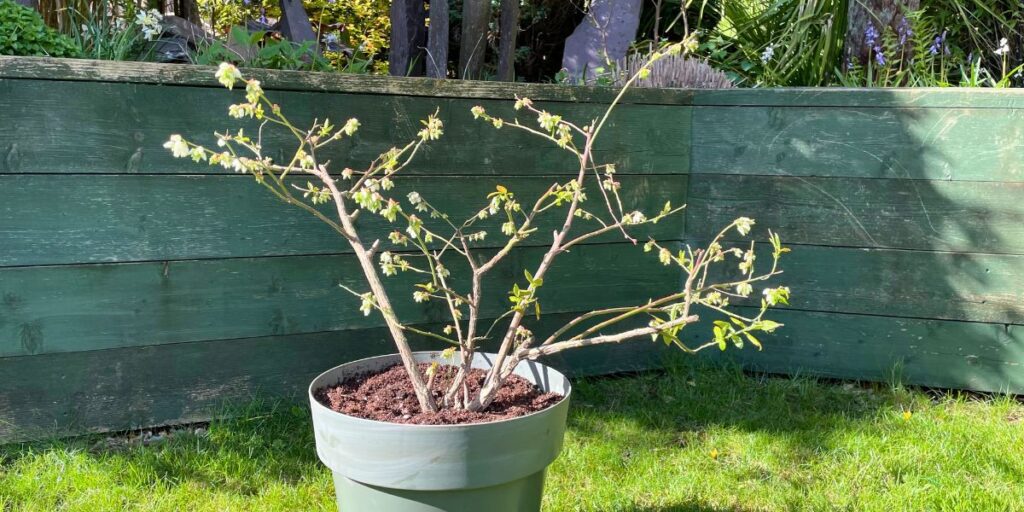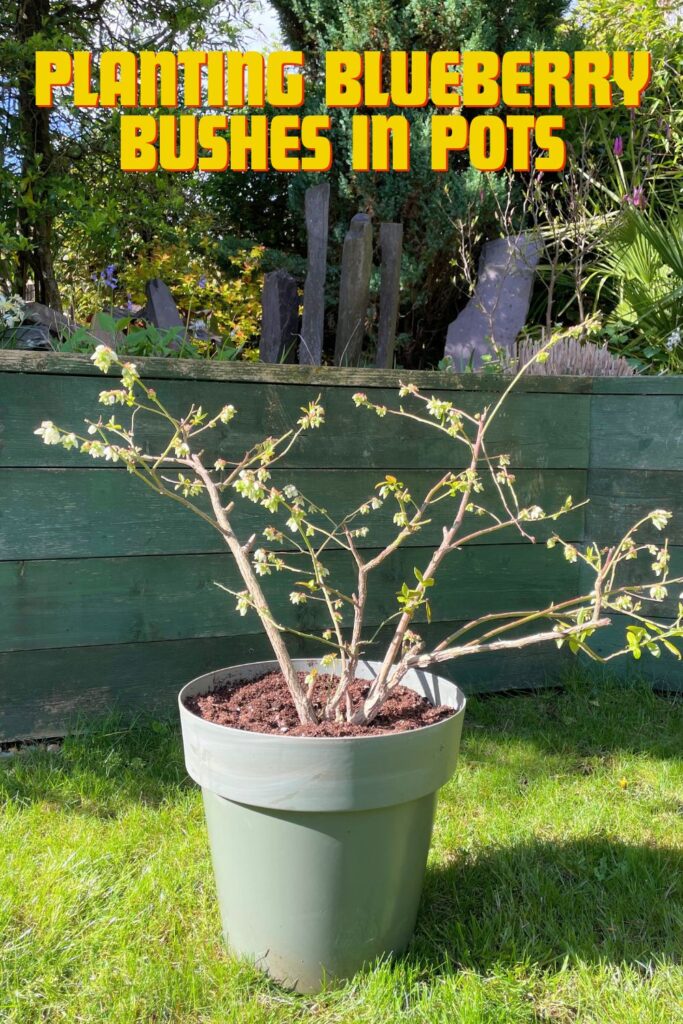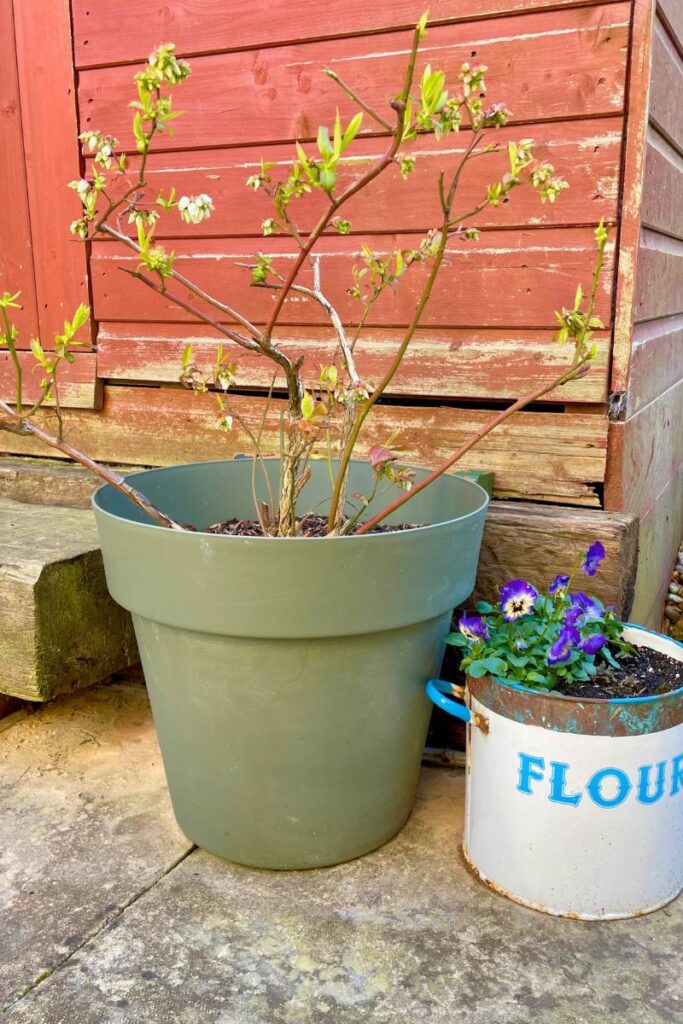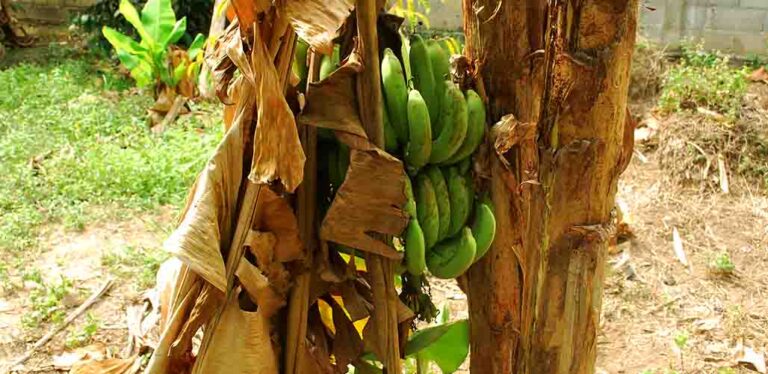Planting Blueberry Bushes In Pots

Planting blueberry bushes in pots is a straightforward way to get around having the wrong soil type, or not having enough space for them in your borders. Containers can even be moved close to the kitchen door as the berries start to ripen – all the better for a convenient and tasty snack! Here are half a dozen blueberries varieties that grow happily in pots, and how to make them feel at home. Because happy plants produce more fruits!
- Why plant blueberry bushes in containers?
- How to choose the best blueberry for your pot
- 6 of the best varieties to try
- Making them feel at home
Why plant blueberry bushes in containers?
Blueberry bushes can be grown in the ground, or in pots. There’s no right or wrong answer here, it’s just about finding the approach which works best for you. The advantages of using containers are:
- Being able to control the soil type. Blueberries have a strong preference for growing in acidic soil. They struggle to thrive and produce very little fruit in neutral or alkaline soils. If you don’t have acidic soil growing in containers is your only chance of success.
- Being able to move them around. Blueberry bushes are usually deciduous, meaning they’re not much to look at in winter. But some have very pretty blossom, and nearly all produce spectacular autumn foliage. Keeping them in pots means you can move them in and out of view, put them into shade on a hot day to conserve water, or put them right by the kitchen door as the berries ripening, for easy access.
- Not needing to put protective netting in your borders. Nearly-ripe blueberries are a popular bird snack, and most gardeners rely on protective netting to prevent birds stealing their harvest. If you don’t have a dedicated fruit bed, planting blueberry bushes in pots means not having to put unattractive protective netting up in your ornamental borders.
Or you might be like me – I planted my blueberry bushes in pots simply because I had run out of space anywhere else!

Drawbacks of growing blueberry bushes in containers
Planting blueberry bushes in pots isn’t without challenges though.
- The setting up costs are greater. Blueberry shrubs yield more fruit if there’s another blueberry from a different variety growing nearby to cross pollinate with. So you’ll need not one, but two large pots. And twice as much compost to fill them, on top of the cost of the bushes themselves.
- Containers dry out faster than soil in the ground. Blueberries aren’t very drought tolerant, so you’ll need to water them regularly in summer. This is made even trickier because calcium oxide in tap water makes potting compost less acidic over time. So ideally you’ll have a water butt to collect rainwater instead.
- Less choice. Some compact blueberry varieties are ideal for growing in pots. And some medium-sized varieties can be kept container-sized through diligent pruning. But ultimately you will have less choice about the types of blueberry you can grow.
How to choose the best blueberry for your pot
There are several ways of categorizing blueberry bushes, such as:
- Highbush vs lowbush (a.k.a. upright vs spreading)
- Compact vs vigorous
- High chill vs low chill
- Early vs late
- Tart vs sweet
Let’s see how you’re supposed to choose between them if your goal is to grow them in a pot.
Highbush vs lowbush
In other words, is their natural silhouette tall, or wide? You can grow either type in a container, but if you’re using a container because you’re trying to make the most of a small yard, then highbush varieties will fit your space better. On the other hand, high bush varieties frequently need vertical support, and if you’re using pots so you can move your blueberry bushes around, then a lowbush variety may be easier to move.
Compact vs vigorous
Compact blueberry bushes are naturally small and slow growing. The smallest reach just 2’ or 3’ tall and wide when they’re fully grown, and get there slowly. Vigorous blueberry varieties on the other hand grow very quickly, and can reach up to 6’ tall. You can grow either type in a container, but vigorous varieties need larger containers, and more pruning.
High chill vs low chill
All varieties of blueberry need some cold weather in winter, in order to produce flowers and fruit. The amount of cold weather they need is measured in chill hours – the number of hours the temperature is below 45°F. ‘High chill’ varieties need a minimum of 800 chill hours over winter. Some low chill varieties can tolerate as few as 150. If you live in a region with mild winters, choose a low chill variety to maximize your harvests, and move it to the coldest spot in your yard over winter.
Early vs mid vs late season
Most blueberries have a 3 – 5 week cropping period, during which they produce ripe fruit. That period can start as early as the beginning of June, or as late as mid-July, depending on the variety. In a stroke of good luck though, early and late varieties still flower around the same time. So you can choose one early fruiting variety and one late fruiting variety, count on their flowers to cross pollinate each other, and enjoy 8 weeks of fresh blueberries. If that’s not something to feel smug about, I don’t know what is!
Sweet vs tart
Like blackberries and cherries, the flavor different blueberry varieties can be placed on a sweet-to-tart spectrum. Which you prefer is a matter of personal taste. Sweet varieties are perfect for a healthy snack or adding to cereal. But tart varieties tend to be firmer, so they’re good for cooking with.
6 blueberry varieties perfect for planting in containers
Here are half a dozen of the blueberries which are best known for performing well in pots. Remember, you need to pick two!
1. Bluejay
A high chill, highbush, mid-season variety, meaning its berries are usually ready to harvest from the middle of July. It’s flavor is mild and sweet, and the berries are notable for freezing and canning well. Bluejay is quite vigorous and may grow up to 5’ tall, so give it the largest pot you can, and control its size by pruning.
2. Legacy
Mid chill, highbush variety which bears fruit from July onwards. The berries are large, sweet, and very dark colored. This variety is unusual for being almost evergreen in mild climates, so it’s good for a small container garden where every plant needs to earn its place, all year round.
3. Patriot
A high chill, lowbush variety developed to cope well in cold, wet regions. Patriot produces unusually large and attractive flowers, which are followed by early season large, sweet fruits. Very popular.
4. Peach Sorbet
A relatively new variety with show stopping foliage that takes on every color from peachy pink, to bright orange, lush green and deep purple over the course of a growing season. The berries are reported to have a mild flavor with hints of pine. Grows to about 3’ tall.
5. Spartan
A high chill, early season variety which is commercially popular for its huge, flavorful berries. It’s a highbush variety, but it’s also quite slender, making it handy for growing in small spaces. Despite their name, Spartan blueberry bushes are particularly fussy about having rich, well drained, acidic compost to grow in – so they usually do best when they’re being pampered in a pot!
6. Sunshine Blue
One of the most versatile blueberry cultivars, with lots of unusual features. Sunshine Blue is a compact low chill variety that’s good for growing in warm regions. It rarely gets any taller than 3’, so it’s a good choice if you don’t have a budget or space for a very large container. What’s more, its flowers are flushed with pink rather than the usual white, and its foliage is evergreen! The berries are an even balance of sweet and tart.

My own potted blueberries are one Duke (an early-fruiting, highbush variety with large, delicately-flavored berries), which was discounted in the garden center at the end of summer. And another unknown variety I received in a plant swap with a friend. Sometimes, the best varieties to grow are the ones which come at the right price!
Growing tips for your potted blueberry bush
Once you’ve chosen your varieties and ordered young plants from a nursery, it’s time to start thinking about making them feel at home. Growing blueberries in containers is really pretty straightforward and satisfying. Here are my top tips for planting blueberry bushes in pots:
- Choose the largest pot you can. Blueberries like moist soil, and large containers dry out more slowly.
- If the pot is made of porous material – like terracotta clay – line the sides with an old compost bag to prevent water evaporation. But leave the bottom bare so it can drain efficiently – most blueberries dislike sitting in waterlogged soil.
- Fill your pot with ericaceous compost. Ericaceous compost is acidic – just how blueberries like it.
- Plant your new bushes to the same depth they were in their nursery pot, or to the soil ‘tide line’ on bare root plants.
- Place the pots within 4 feet of each other to guarantee cross pollination in spring and larger harvests in summer.
- Try to choose a location where they’ll receive at least 6 hours of sunshine a day, or as close to it as possible.
Caring for your potted blueberry bushes
Once your blueberries are settled in:
- Keep the soil moist but not waterlogged. Ideally, water your blueberries with rainwater from a water butt in summer, but tap water is better than no water at all, so don’t overthink using it when your rain water supplies run dry.
- Mulching the top of your pot with pine needles is a good way of trapping moisture below. Pine needles turn into acidic compost when they break down, so they won’t disturb the pH balance of the potting mix.
- Feed your bushes with ericaceous fertilizer once a month between April and September.
- When the berries start to ripen, net your bushes or put a fruit cage over them to keep away birds (and in my experience, dogs!)
After the second or third year, you bushes might need repotting into larger containers if they are particularly big. Most varieties eventually need a plant pot with a diameter of about 20 inches. From the third year onwards, you’ll also need to prune your bushes in winter. This can be done in 3 easy steps:
- Completely remove any dead or diseased stems, any limbs that rub against another, and any branches lying flush to the surface of the compost.
- Cut back any spindly shoots from last year to a strong leaf bud.
- And remove around ¼ of the oldest branches as close to the base of the plant as possible, to encourage newer, more productive stems to appear.
Planting blueberry bushes in pots – summary
Blueberries need acidic soil, and growing them in containers is an easy way to overcome not having that in your yard or vegetable garden. I keep my potted blueberry bushes on a warm sunny patio near the kitchen door in summer. It helps the fruit ripen, and it’s convenient for picking them! In fall, I move them further away from the house, so we can more easily admire their changing color from the windows. This year I might even place them either side of my front door to impress visitors!
Planting blueberries in pots is straightforward, fun, and satisfying. I hope you’ll give it a go too – let me know what variety you have in mind in the comments box down below!

